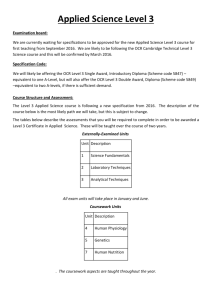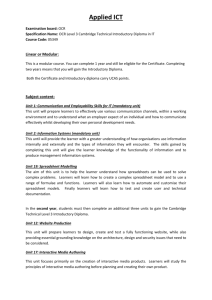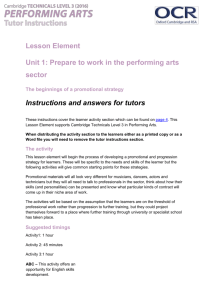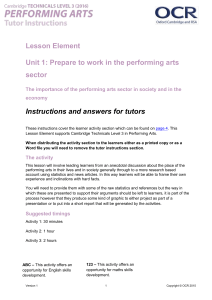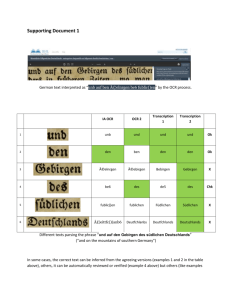Cambridge Technicals Level 3 Perfoming Arts U02 Lesson Element 2
advertisement
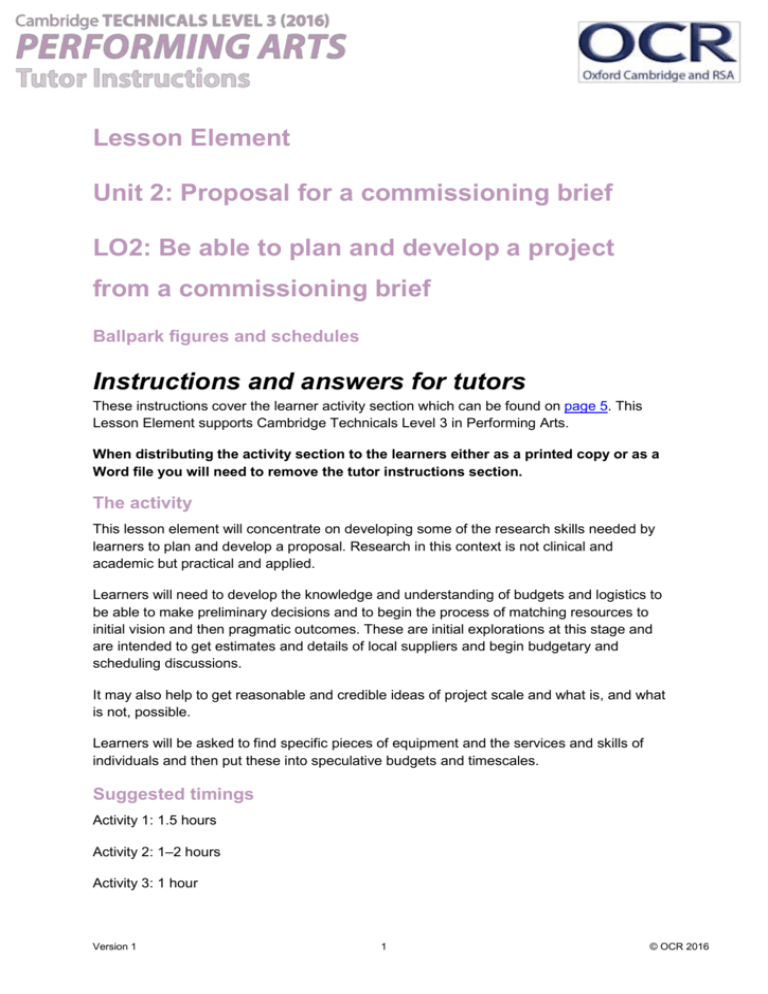
Lesson Element Unit 2: Proposal for a commissioning brief LO2: Be able to plan and develop a project from a commissioning brief Ballpark figures and schedules Instructions and answers for tutors These instructions cover the learner activity section which can be found on page 5. This Lesson Element supports Cambridge Technicals Level 3 in Performing Arts. When distributing the activity section to the learners either as a printed copy or as a Word file you will need to remove the tutor instructions section. The activity This lesson element will concentrate on developing some of the research skills needed by learners to plan and develop a proposal. Research in this context is not clinical and academic but practical and applied. Learners will need to develop the knowledge and understanding of budgets and logistics to be able to make preliminary decisions and to begin the process of matching resources to initial vision and then pragmatic outcomes. These are initial explorations at this stage and are intended to get estimates and details of local suppliers and begin budgetary and scheduling discussions. It may also help to get reasonable and credible ideas of project scale and what is, and what is not, possible. Learners will be asked to find specific pieces of equipment and the services and skills of individuals and then put these into speculative budgets and timescales. Suggested timings Activity 1: 1.5 hours Activity 2: 1–2 hours Activity 3: 1 hour Version 1 1 © OCR 2016 Activity 1 Ask learners to get into small groups and quickly brainstorm a project that they would take on a small-scale tour of schools and/or community centres. The performance or workshop details are not the issue as the activity will involve sourcing portable lighting, sound and staging equipment and producing costings, but an idea of why this equipment is necessary would be a good starting point. The exact details are up to them but you could suggest a small stage, two lighting bars with four lamps on each and a sound system. Resources for the research will depend on local availability but general sites and directories will provide some basic prices; learners should take account of costs involved with picking equipment up and getting it to a company base. Examples of hire companies that will provide prices and quotes include: www.hire-a-stage.com www.hawthorns.uk.com www.ukstagehire.com Some of these will ask for details before quoting while others will give some idea of prices on the site. This is a short activity to begin the research process and get ballpark figures; learners could only need to get two prices per piece of equipment – lighting rig, sound system, stage. They could come back to a subsequent session with these quotes. Activity 2 Ask learners to consult professional websites to find current rates of pay and allowances for a small-scale tour. Alternatively you could ask learners to find a range of these pay rates that they can draw on to produce a fees budget. A good source of these is at www.uktheatre.org which has a page listing contractual rates of pay for actors, dancers and technicians as well as creative staff such as directors. You could also go to the union sites and professional organisations. Unions: www.equity.org.uk www.bectu.org.uk Version 1 2 © OCR 2016 www.musiciansunion.org.uk www.stagemanagementassociation.co.uk Professional organisations: Independent Theatre Council www.itc-arts.org UK Theatre Association www.uktheatre.org Society of London Theatre www.solt.co.uk Learners should be asked to make some early decisions on the nature of the proposed performance and/or workshops and who they will need to pay and over what period. Working in the day or evening and the kind of venue will also have an impact. Activity 3 Using some of the speculative decisions and proposals outlined in previous activities (equipment/people costs) learners should be asked to rough out a schedule for the project. As in previous activities this activity is to explore the scheduling process itself and does not necessarily involve final decisions or exact details. To do this they could asked to fill in a Gantt chart, that could be either be a template supplied by you or one that they could source themselves. A simple example based on a word table is given below; examples of charts can be found at: www.exceltemplates.org Task Research Rehearse Perform Evaluate PIC Week one All Jon All Sal Week two Week three Week four Week five Week six Additional columns can be slotted in for specific deadlines and production meetings for example, so in reality each weekly column will need to show all days. But it could be that Version 1 3 © OCR 2016 when given the simple chart learners will be asked to add the complications and expand the chart to account for more detailed scheduling. We’d like to know your view on the resources we produce. By clicking on ‘Like’ or ‘Dislike’ you can help us to ensure that our resources work for you. When the email template pops up please add additional comments if you wish and then just click ‘Send’. Thank you. If you do not currently offer this OCR qualification but would like to do so, please complete the Expression of Interest Form which can be found here: www.ocr.org.uk/expression-of-interest OCR Resources: the small print OCR’s resources are provided to support the teaching of OCR specifications, but in no way constitute an endorsed teaching method that is required by the Board, and the decision to use them lies with the individual teacher. Whilst every effort is made to ensure the accuracy of the content, OCR cannot be held responsible for any errors or omissions within these resources. © OCR 2016 - This resource may be freely copied and distributed, as long as the OCR logo and this message remain intact and OCR is acknowledged as the originator of this work. Please get in touch if you want to discuss the accessibility of resources we offer to support delivery of our qualifications: resources.feedback@ocr.org.uk Version 1 4 © OCR 2016 Lesson Element Unit 2: Proposal for a commissioning brief LO2: Be able to plan and develop a project from a commissioning brief Learner Activity Ballpark figures and schedules In this lesson element you will be asked to carry out short research tasks that will give you some ‘ballpark’ figures relating to a possible project. It will give you the confidence to seek the best deals and to be realistic about what’s possible – although this is not intended to be a cost-saving exercise, it is simply to get some figures; it may be that you have ambitious plans for a project and that would be acceptable – as long as you know the logistics and costs involved. You will also begin to think about schedules and timelines based on the information you are given and on previous lessons where we have looked at organisational needs and demands. Activity 1 In this activity you will decide on the equipment that you will need for a tour of schools and/or community centres. You should assume that as part of the proposal or grant application you intend to put together you will need to make general statements about equipment hire costs. The issue with this is that you don’t yet know exactly how the show will turn out as you haven’t started rehearsing yet! However this is not unusual and sometimes as a company you have to speculate about the mostly likely scenario, or maybe your optimum needs. Before you get the quotes in you will need to make some basic decisions about your potential requirements regarding: staging lighting sound. Version 1 5 © OCR 2016 You may not know the details of the show but you know if you will want to dance, do physical theatre, or play in a band. You may know you want levels, maximum light or minimal amplification, so these will affect the spec of the equipment needed. Once these rough requirements have been noted you will need to get the quotes or ballpark figures. Some sites will require you to fill in a form and submit for a quote but others such as www.hire-a-stage.com have figures on the page. You may also need to make a couple of calls. Bring these figures back to the next session. Activity 2 In this activity you will produce a budget that estimates fees and costs of personnel and artists. Decisions on the possible performance and/or workshop will determine these costs; in other words, you shouldn’t arbitrarily decide that you want four actors and a technician unless you believe that this is the most likely outcome of the work you intend to create. However it is also possible that you will make work for the amount of people and skills that you have in the group that you are currently working in. You should assume that workers will be employed on appropriate professional contracts that include: weekly rates fees for creative staff (directors, choreographers, musical directors etc) subsistence payments additional payments for overtime, if appropriate rehearsal and/or performance rates. You should then consider the timescale of employment and total for these figures to form an overall pay cost. Version 1 6 © OCR 2016 Activity 3 In this activity you will begin to explore how scheduling and timelines work. This will result in a chart (or series of charts) that provide a graphic representation of all the work that needs to be done to get a project on the road and completed. You should start with four basic stages to the project: research rehearse perform evaluate. These have been put into a simple chart below. This is merely a simple chart as indicated and you will need to complete this by adding days of the week, other kinds of meetings or sub-dividing the four headings to take account of the specific elements in your project. For instance, research might include days when working individually on character development or in groups on themes and ideas. The point of this activity is to have the conversation on the stages of a project and how these can be codified in a scheduling chart. Task PIC Week one Research Rehearse Perform Evaluate Version 1 Week two Week three 7 Week four Week five Week six © OCR 2016


